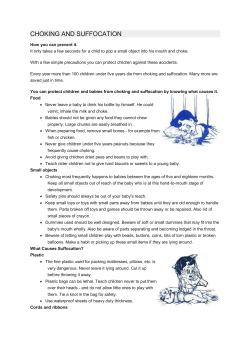
You can this checklist as a printable PDF here
Childproofing Checklists BY DEVELOPMENT / AGE Newborn Before Baby is On-the-Go It makes sense to begin child proofing before your child is on the go. Installing safety products develops good habits in parents and teaches children what is off-limits. Young babies reflexively bring their hands to their mouths, so it’s important to think about choking hazards from an early age. Begin child proofing your home by doing the following: Make sure baby’s crib adheres to current safety standards as specified by the US Consumer Product Safety Commission. Keep baby’s crib free of pillows, bumpers, stuffed animals, and blankets. Place baby monitors and their electrical cords at least three feet away from the crib. Retrofit or replace any corded window coverings. Any cord is a hazard. Use hands-on supervision during bath time and on the changing table. Install smoke alarms and carbon monoxide detectors. Crawling Get in the habit of closing the toilet lid; consider installing a latch. Install gates to prevent access to stairs and other areas parents wish to keep off-limits. Adjust water heater temperature to 120 degrees Fahrenheit. Create a storage area for purses and briefcases that is out of reach of children. Anchor TVs and furniture, including dressers and bookcases. Install a fence around any pool or hot tub. Install a pool alarm. Curious Explorers Crawling and cruising children will grab onto almost any surface and may pick up any visible item. Everything is new and exciting to them and they like to check out new items by tasting them. Make sure that crawlers can only access areas free of harm. As soon as your child begins rolling over, take care of all the items on the newborn list. In addition, child proofing for curious crawlers includes new steps. Cover electrical outlets lower than counter height and select products that are not choking hazards. (Remember your kitchen island!). Ensure that the area three to four feet up from the floor is free of choking hazards, including loose change, marbles, and rubber bands. Remove nightlights in any lower outlets. Keep household cleaners and medicines up high (latches help, but children can defeat them). Use stationary play centers, not baby walkers. Cover sharp furniture edges and corners (or remove furniture). Pack up and put away breakables and valuables. Keep items away from the edges of tables and countertops. Secure and hide electrical cords, including lamp and appliance cords. Install latches on appliance and oven doors, or keep them securely closed at all times. Learn and post the number for Poison Control: 1-800-222-1222. Turn pot handles inward on the stove and use back burners. Ensure stoves are anchored. Empty bathtubs and buckets of water immediately after use. Ask older siblings or visiting children to pick up their toys carefully after playing with parents double checking the area. Toddler Very Active & Finds Trouble Quickly Toddlers walk, run, and climb. As they won’t always follow your instruction of “No,” it is best to have safety gates installed early so that your child knows which rooms are off-limits. Be prepared to give lots of clear reminders about safety, as children this age cannot remember even simple rules. Make sure that the steps in the previous stages have been completed, and work on the following as well. Keep windows latched. Screens will not protect a child from a window fall. Secure doors to off-limit areas such as cellars and garages. Lock doors to the outside. Install stove knob covers. Keep household medications in child resistant containers and in a high cabinet. Create a space out of reach of children for small electronic devices to rest and charge. Never refer to medicine as “candy” or take your medicine in front of them. Toddlers like to imitate adults. Place hot foods and liquids on the center of tables and countertops, not on edges, table cloths or placemats. Unplug small appliances and keep them out of reach. Be careful with chairs & step stools especially for climbers! Remove sharp items from countertops. Ensure couches and other furniture are not placed next to balconies or railings. Child The More they Do, the More Dangers they Find Children ages three to five can understand why some items and actions are dangerous. Nonetheless, their impulses often push them to do what they know is forbidden. Your child will have likely outgrown their crib. At this age, children may use their improved motor skills to investigate rooms and items which have been designated off-limits. Double-check previously installed latches, locks, and gates, to see if your child is now able to overcome them. Explain to your child why certain items are dangerous, but do not expect them to obey you at all times. Continue keeping cleaners and medications out of reach. Teach children how to respond to the sound of a smoke alarm at home. Make an escape plan, and practice it with your kids. Check your smoke alarms each month. Keep matches and lighters up highand out of reach. Install window stops or guards on windows on upper floors. Do not allow children this age to use a microwave. Teach your child his or her full name, street address, and phone number. Continue adult supervision during bath time. Keep firearms unloaded and locked in a cabinet. Remove or retrofit any storage trunks or chests which cannot be opened from the inside. Childproofing tasks should be started as soon as possible because children grow and develop at different rates. Remember, childproofing does not eliminate the need for supervision! Learn more and find more valuable resources at: childproofingexperts.com This list does not include all the possible hazards that exist in homes. This information is meant to be one of many resources you use in protecting your children.
© Copyright 2025











